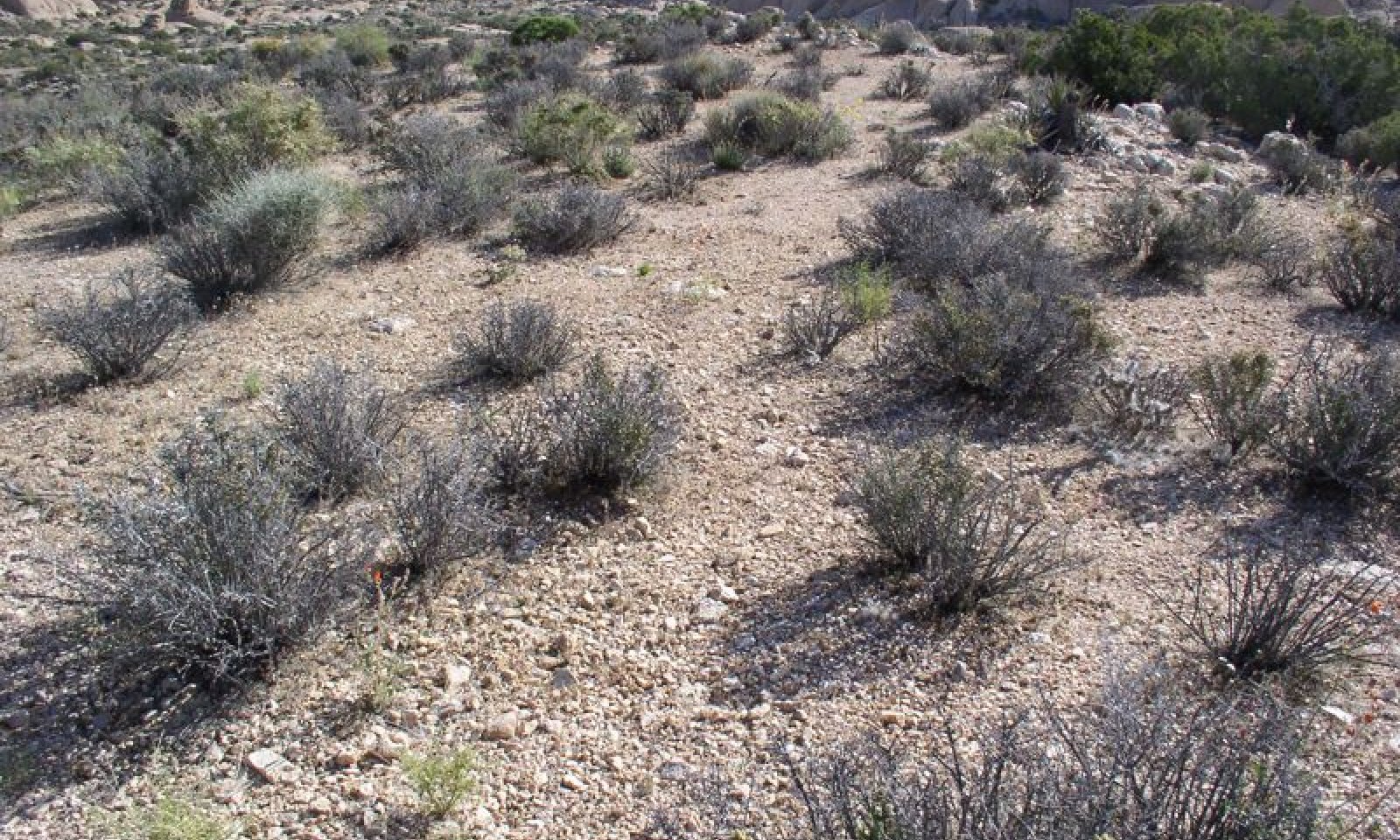
Dissected Pediment, Cool
Scenario model
Current ecosystem state
Select a state
Management practices/drivers
Select a transition or restoration pathway
- Transition 1 More details
- Transition 2 More details
- Restoration pathway 1 More details
- Transition 3 More details
-
No transition or restoration pathway between the selected states has been described
Target ecosystem state
Select a state
Description
State 1 represents the historic range of variability for this ecological site. This state no longer exists due to the ubiquitous naturalization of non-native species in the Mojave Desert. Periodic drought, erosion, and very rare fire were the natural disturbances influencing this ecological site.
Blackbrush is killed by moderate to severe fire, and the historic fire return interval is suggested to be upwards of 100 years (Webb et al. 1987, Brooks et al. 2007, Abella et al. 2009). With the absence of non-native species to fuel recurrent fires, this long fire-return interval allowed for recovery to pre-burn densities. California juniper is also killed by moderate to severe fire, but in can re-colonize burned areas if the fire return interval is greater than 15 years (Cope 1992).
Data for this State does not exist, but it would have been similar to State 2, except with only native species present. See State 2 narrative for more detailed information.
State 2
Reference State





Description
State 2 represents the current range of variability for this site. Non-native annuals, including red brome and cheatgrass are naturalized in this plant community. Their abundance varies with precipitation, but they are at least sparsely present (as current year's growth or present in the soil seedbank).
Submodel
Description
This state is characterized by the loss of blackbrush from the plant community due to severe or recurrent fire.
Submodel
Description
This state develops after repeat disturbance in the reference or blackbrush lost communities. This state has been significantly altered from the natural range of variability found in States 1 through 3. Blackbrush and California juniper have been lost, and non-native annual grasses, native sub-shrubs, perennial grasses, and short-lived shrubs dominate the community, or in the eroded phase, bare ground dominates.
Submodel
Mechanism
This transition occurred with the naturalization of non-native species in this ecological site. Non-native species were introduced with settlement of the Mojave Desert region in the 1860s.
Mechanism
This transition occurs with extensive, severe fire when blackbrush seed sources are not available to colonize burned areas, or with recurrent fire.
Mechanism
Restoration of arid desert communities severely altered by repeat fire at the landscape scale is very difficult (Allen 1993). Reducing invasion of non-native grasses that increase after fire may help promote native plant recovery, and reduce the probability of repeat burning (Fuhrmann et al. 2009, Matchett et al. 2009, Steers and Allen 2010); however, accomplishing this at a landscape scale, for a time period long enough to be effective, has not yet been accomplished. In small-scale trials, Fusilade, a grass-specific herbicide, was successful in reducing invasive grasses in burned creosote bush communities in the Colorado Desert in the initial three years after fire (Steers and Allen 2010). The long-term efficacy of such treatments on a landscape scale, and non-target effects have not yet been determined. The pre-emergent herbicide Plateau was applied in conjunction with aerial seeding of natives after fire in Zion National Park (Fuhrmann et al. 2009, Matchett et al. 2009). Initial results indicate that autumn application of Plateau after fire is most effective for reducing cheatgrass (Bromus tectorum), but longer-term monitoring is needed to evaluate long-term and non-target effects. In addition to controlling invasive species, active recovery of native vegetation may be attempted. Methods may include seeding of early native colonizers such as desert globemallow, burrobrush, threeawns (Aristida spp.), and desert marigold (e.g. Abella et al. 2009, Abella et al. 2012). Increased native cover may help to reduce non-native plant invasion, helps to stabilize soils, provides a source of food and cover for wildlife, including desert tortoise (Gopherus agassizii), and provides microsites that facilitate blackbrush establishment. However, the amount of seed required for success is often prohibitive. Large-scale planting of both early colonizers and community dominants tends to be more successful in terms of plant survival, especially if outplants receive supplemental watering during the first two years (Allen 1993). Blackbrush is difficult to cultivate for outplanting due to susceptibility to fungal pathogens in the greenhouse environment.
Model keys
Briefcase
Add ecological sites and Major Land Resource Areas to your briefcase by clicking on the briefcase (![]() ) icon wherever it occurs. Drag and drop items to reorder. Cookies are used to store briefcase items between browsing sessions. Because of this, the number of items that can be added to your briefcase is limited, and briefcase items added on one device and browser cannot be accessed from another device or browser. Users who do not wish to place cookies on their devices should not use the briefcase tool. Briefcase cookies serve no other purpose than described here and are deleted whenever browsing history is cleared.
) icon wherever it occurs. Drag and drop items to reorder. Cookies are used to store briefcase items between browsing sessions. Because of this, the number of items that can be added to your briefcase is limited, and briefcase items added on one device and browser cannot be accessed from another device or browser. Users who do not wish to place cookies on their devices should not use the briefcase tool. Briefcase cookies serve no other purpose than described here and are deleted whenever browsing history is cleared.
Ecological sites
Major Land Resource Areas
The Ecosystem Dynamics Interpretive Tool is an information system framework developed by the USDA-ARS Jornada Experimental Range, USDA Natural Resources Conservation Service, and New Mexico State University.


